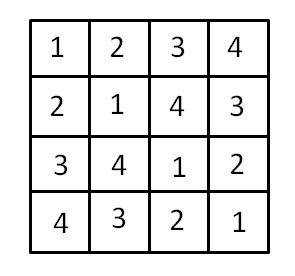気になっていた群の性質
群のoperation tableを見ていてずっと気に成っていたことがありました。ちょうどそれに関する証明問題があったので解いてみました。
For any two elements x and y in G, there is an element z in G such that y = xz.
上の内容は0以外の実数集合と乗算演算からなる群<R*, ・>の場合、あたり前のことを言っています。任意の実数x, yについて、z = y/x とすれば、y = xzが成り立ちます。この関係が有限群でも成り立つのかどうかは興味深いです。これまでいくつかの群構造を見てきましたが、そのすべてにおいて上の関係が成り立っていました。
以下考えた証明です。
Let x be an element in G.
Apply the operator to x with all the elements in G, namely x1, x2, .... xn.
xx1, xx2, ....., xxn (1)
Since G is closed with respect to the operation, all the above results are belong to G.
If xxi = xxj, by canceling x from the both sides, xi = xj. So if xi ≠ xj, then xxi ≠ xxj holds.
Therefore, it comes down to that (1) is a permutation of x1, x2, ....., xn,
which follows that for any x and y G, there is an element z such that y = xz.
ラテン方格とは?
証明を考えているときに、これってラテン方格だよなーと思って調べてみました。ラテン方格とは、n*nの格子でどの列を見てもどの行を見ても[1, n]の値が1回ずつ出てくるような格子です。

群構造とラテン方格の関係
群構造を持つ代数系のoperation tableを書くとラテン方格になります。上の証明で行に関してはpermutationになっていることを示しています。列に関しても同様に示すことができます。
operation tableがラテン方格でも、必ずしも群にはならないようです。この群のようで群じゃない代数構造をquasigroup(日本語だと準群??)と呼ぶそうです。また、identity elementを持つ quasigroup をloopと呼ぶそうです。
